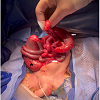A case of prenatally diagnosed prune belly syndrome variant and congenital pouch colon in the United States: A case report
DOI:
https://doi.org/10.52783/jns.v10.1012Keywords:
Prune belly syndrome, Congenital pouch colon, Congenital colovesicular fistula, Anorectal malformationAbstract
Background: Prune belly syndrome (PBS) and congenital pouch colon (CPC) are rare congenital syndromes with a low incidence in the United States (U.S.) with most CPC cases being from India. In this case report, we describe, to the best of our knowledge, the first PBS variant and CPC patient in the U.S.
Case Presentation: A 30-year-old G2P0010 woman was referred to a tertiary center after an 18-week ultrasound showed a fetal abdominal mass. A prenatal MRI showed a dilated loop of bowel containing a mixture of urine and meconium, oligohydramnios, and a protuberant abdominal wall. Born at 37 weeks, the child’s physical exam was notable for a distended abdomen with thin abdominal musculature, non-palpable bilateral testes, no anal opening, and flat buttocks. Intra-operatively, a dilated cecum/ascending colon was noted with an abrupt change in caliber at the transverse colon, bilateral enlarged ureters, a left testis at the internal ring and no visualized right testis. A colostomy and mucous fistula were created 5 cm from the sigmoid pouch.
Conclusion: While most reported cases of CPC undergo single stage repair (one operation) at 1 day of life, our patient underwent the first procedure of a staged repair at 16 hours of life given his clinical instability at the time as well as his unknown urological anatomy in the setting of urinary obstruction. This case demonstrates the importance of fetal imaging, multidisciplinary approach at a tertiary care center, and reinforces a staged repair when necessary.
Downloads
Metrics
References
Routh JC, Huang L, Retik AB, Nelson CP. Contemporary epidemiology and characterization of newborn males with prune belly syndrome. Urol. 2010; 76:44-8.
Walker J, Prokurat AI, Irving IM. Prune belly syndrome associated with exomphalos and anorectal agenesis. J Pediatr Surg. 1987; 22:215-7.
Chadha R. Congenital pouch colon associated with anorectal agenesis. Pediatr Surg Int. 2004; 20:393-401.
Angotti R, Salih Q, Molinaro F, Ferrara F, Sica M, Bindi E, et al. Congenital pouch colon associated with anorectal malformation: A rare anomaly of Asian Region – experience of Kurdish centre. Afr J Pediatr Surg. 2018; 15:5.
Ghritlaharey R, Budhwani KS. Two-staged management for all types of congenital pouch colon. Afr J Pediatr Surg. 2013; 10:17-23.
Gondolesi G, Ramisch D, Padin J, Almau H, Sandi M, Schelotto PB, et al. What is the normal small bowel length in humans? first donor-based cohort analysis. Am J Transplant. 2012; 12:S49-54.
Singh S, Rawat JD, Kumar P. Congenital pouch colon: Our experience with coloplasty. Afr J Paediatr Surg. 2018; 15:16-21.
Mathur P, Saxena AK, Simlot A. Management of congenital pouch colon based on the Saxena-Mathur classification. J Pediatr Surg. 2009; 44:962-6.
Ghritlaharey RK, Budhwani KS. Two-staged management for all types of congenital pouch colon. Afr J Paediatr Surg. 2013; 10:17-23.
Yadav K. Short colon associated with the prune belly syndrome. Int Surg. 1979; 64:83-5.
Bangroo AK, Tiwari S, Khetri R, Sahni M. Congenital pouch colon with prune belly syndrome and megalourethra. Pediatr Surg Int. 2005; 21:474-7.
Baba AA, Hussain SA, Shera AH, Patnaik R. Prune belly syndrome with pouch colon and absent dermatome. Afr J Paediatr Surg. 2010; 7:25-7.
Ragavan M HU, Pradeep PV, Sarvavinothini J. Rare association of prune belly syndrome with pouch colon. Pediatric Health, Medicine and Therapeutics. 2011; 2:9-12.
Annigeri VM, Bhat MT, Hegde HV, Annigeri RV, Halgeri AB. Prune belly syndrome with congenital pouch colon. J Indian Assoc Pediatr Surg. 2013; 18:79-80.
Garge S, Bawa M, Rao KL . Prune belly syndrome with pouch colon with scaphoid megalourethra: a newer embryological and prognostic perspective. Ann Pediatr Surg. 2015; 11:42-5.
Raj P, Birua H. Type V pouch colon, prune belly syndrome, and congenital anterior urethrocutaneous fistula. J Neonatal Surg. 2017; 6:38.

Published
How to Cite
Issue
Section
License
Copyright (c) 2021 Mignote Yilma, Karen Trang, Marisa Schwab, Max Bowman, Mark Sugi, Jesse Courtier, Laurence Baskin, Doruk Ozgediz

This work is licensed under a Creative Commons Attribution 4.0 International License.
You are free to:
- Share — copy and redistribute the material in any medium or format
- Adapt — remix, transform, and build upon the material for any purpose, even commercially.
Terms:
- Attribution — You must give appropriate credit, provide a link to the license, and indicate if changes were made. You may do so in any reasonable manner, but not in any way that suggests the licensor endorses you or your use.
- No additional restrictions — You may not apply legal terms or technological measures that legally restrict others from doing anything the license permits.










